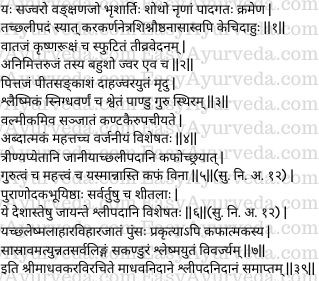Madhava Nidana Chapter 39 Shlipada Nidanam
Table of Contents
Introduction
This article explains Madava nidana 39th chapter “Shlipada Nidanam”. Causes, pathology and symptoms of Shlipada are explained in this chapter.
Read – Acharya Madhavakara: His Work ‘Madhava Nidana’, Legacy, Amazing Facts

Shlipada Samanya Lakshana
General Symptoms
A swelling starting in the groins and gradually moving towards (involving) the leg, associated with fever and severe pain is known as Shilpada. According to the opinion of others (experts) shlipada may occur even in the hands, ears, eyes, penis, lips and nose. (1)
Symptoms of Doshaja Shlipada
Vataja Shlipada – In this condition the swelling is black, dry and has fissures, (cracks). There is severe pain which appears without any apparent reason and is covered with fever.
Pittaja Shlipada – In this condition there is yellowish discolouration. It is associated with burning sensation and fever and the swelling is soft to touch.
Kaphaja Shlipada – Here the swelling is unctuous (oily). It is white or pale in colour, is heavy and fixed (immobile). (2-3)
Read – Elephantiasis: Ayurvedic Treatment, Medicines, Remedies
Sanskrit Versus

Asadhya Lakshana
Symptoms of incurability
The swelling of slipada growing upwards like an ant-hill with many small hill-like projections and sprouts (knots), that which exists for more than one year, and that which is very big in size are to be rejected (should not be treated because such shlipada is incurable). (4)
Kapha predominance in all types of Shlipada
In all the three varieties of shlipada, kapha is the predominant doșha, because heaviness and increase in size cannot be caused without kapha.(5)
Places where Shlipada is prevalent
Shlipada is generally prevalent in such places (areas) where there is stagnation of water for a long period of time, in places wherein there is excessive cold in all the seasons of the year. (6)
Other symptoms of incurability of Shlipada
Shlipada should be rejected (should not be treated) when it is caused due to excessive indulgence in foods and habits which increase kapha, in those who are of kapha prakriti (whose birth constitution is predominantly kapha) and when the disease presents with exudation, is very big in size, is associated with all the signs and symptoms and has itching. (7)
Thus ends the chapter on shlipada Nidanam in Madhava Nidana text written by Acharya Madhavakara.









